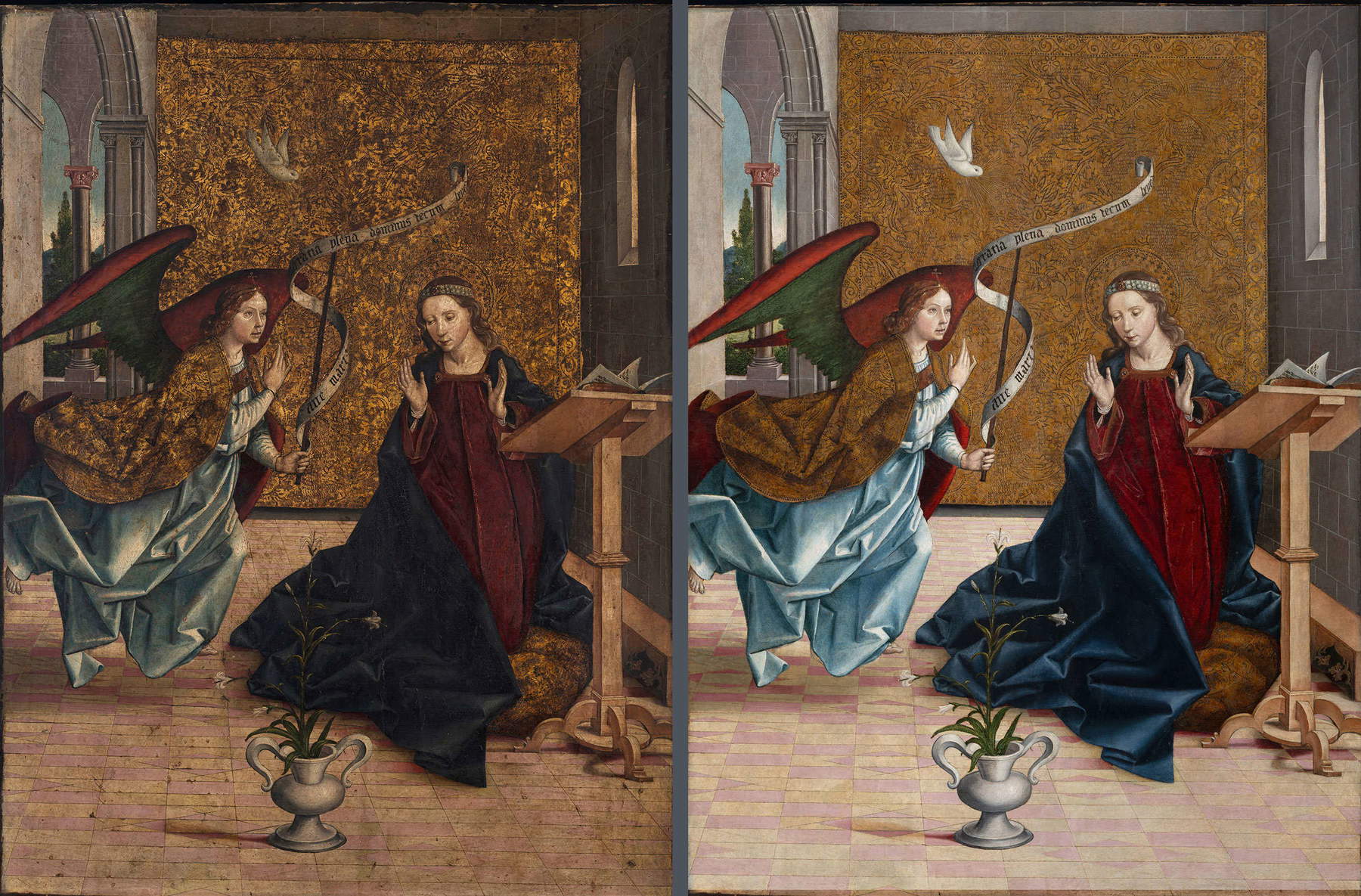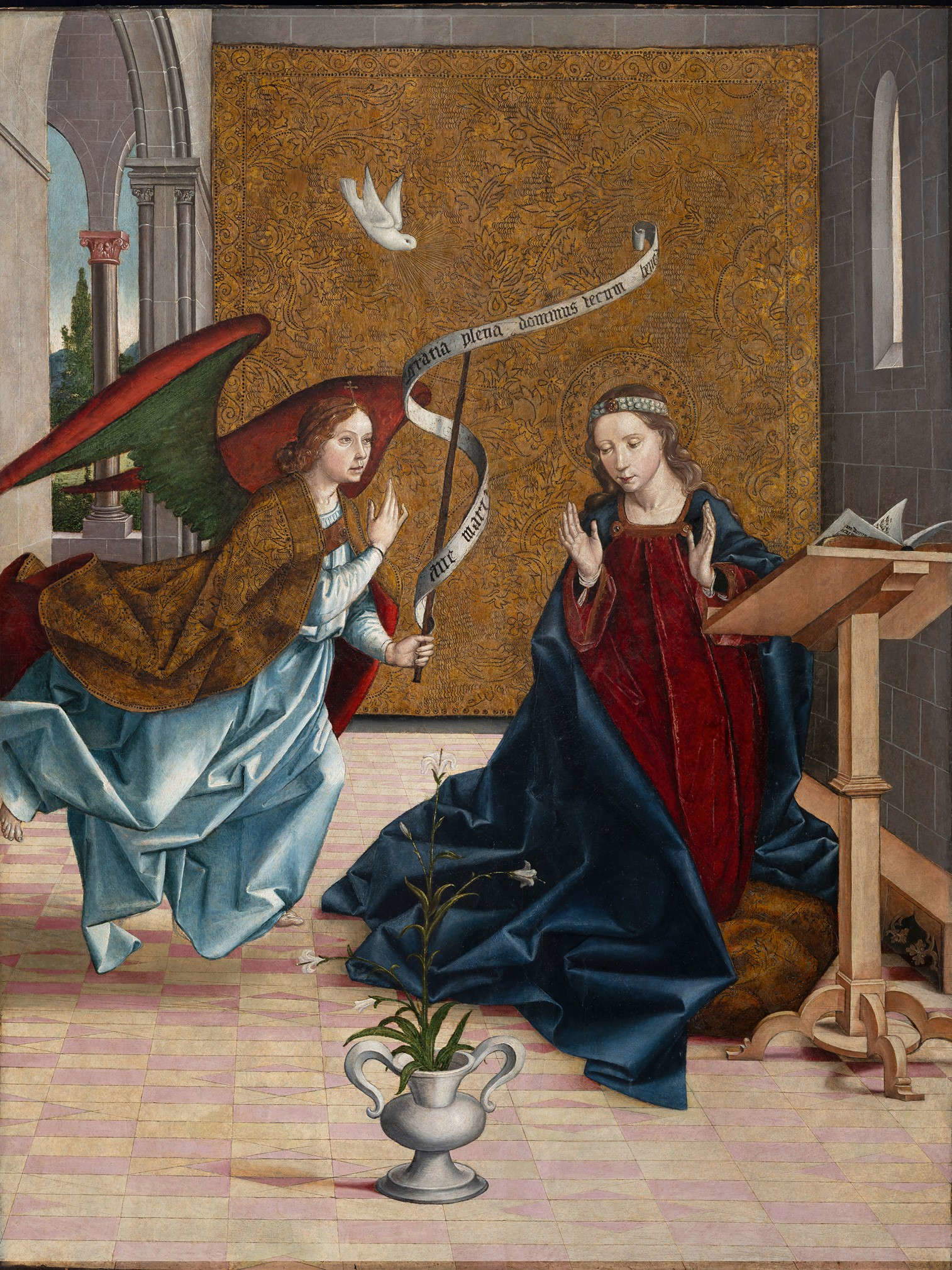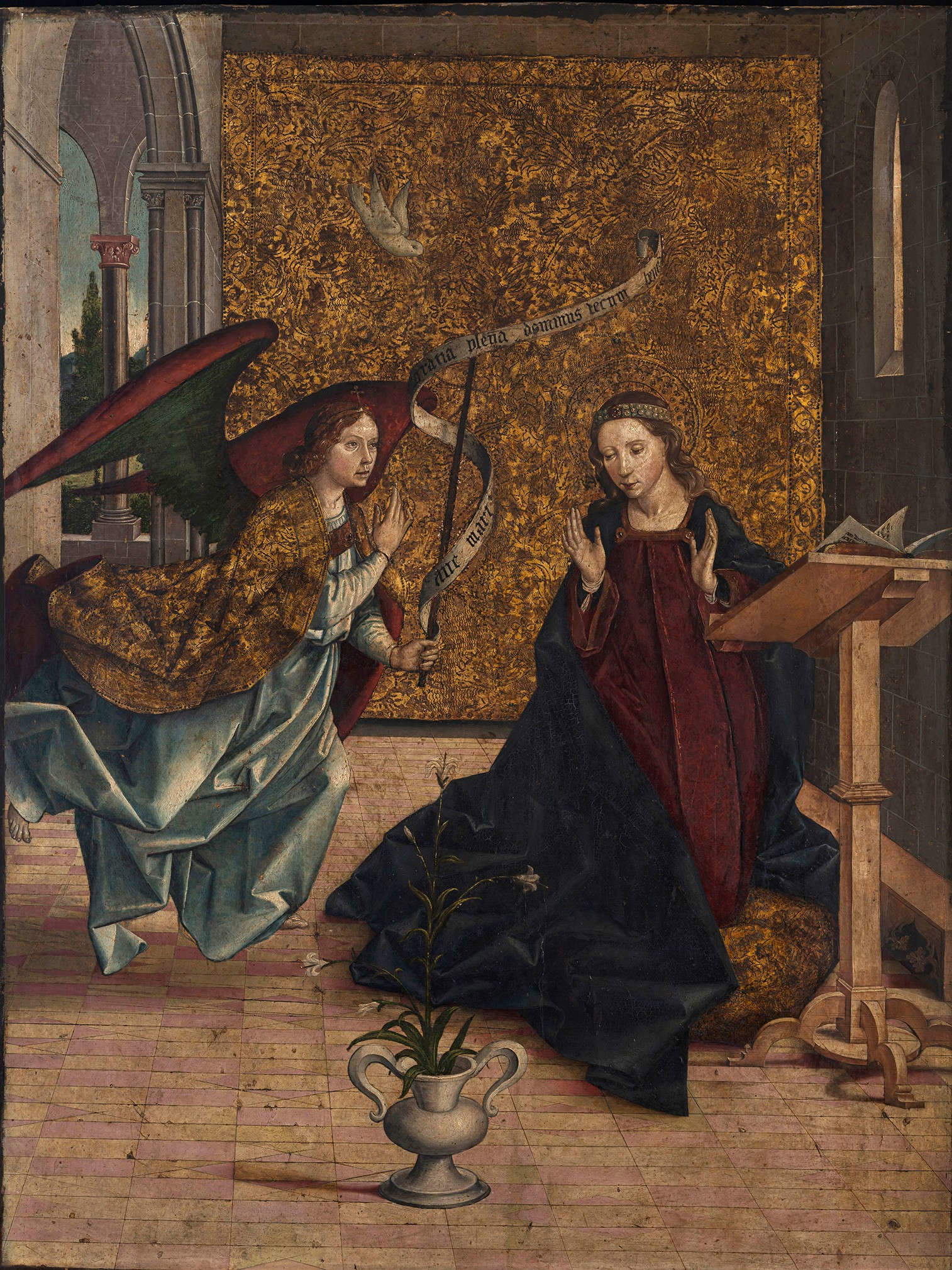A masterpiece by Pedro Berruguete, one of Spain’s greatest Renaissance painters, is being revived thanks to careful restoration. It is theAnnunciation, a work currently housed at the Museo de Bellas Artes in Bilbao (Basque Country, Spain), where it has been on deposit for five years from the Arburua private collection. The operation, financed by Iberdrola, Spain’s leading electricity company, is part of the company’s annual action plan, whose primary objective is to ensure the material integrity of artworks for the purpose of their proper conservation and display. It also aims to publicly disseminate the results of this fundamental work of the museum.
Pedro Berruguete’sAnnunciation , a work datable to around 1485-1490, has always been kept by private individuals and was therefore a little-known work. The restoration was supervised by Elisa Mora Sánchez, a restorer at the Prado Museum until 2021, who handled the treatment of the work’s pictorial elements, and Mayte Camino Martín, a frame restorer at the Prado, who handled the treatment of the gilded backgrounds. The study of the work was instead carried out by Pilar Silva Maroto, a historian specializing in Hispano-Flemish and early Renaissance painting , as well as curator of the Prado Museum until 2017: she examined the work from a historical and stylistic perspective in the context of other paintings by the artist depicting the same iconography. The result of this analysis has already been published in scholarly circles. The project was coordinated by José Luis Merino Gorospe, curator of ancient art at the Bilbao Museum of Fine Arts.

Of unknown origin, Berruguete’sAnnunciation is documented by a single photograph dated 1916, suggesting that it was restored throughout its history before passing, probably in the 1950s, to the current collection. Because of its style, characteristic of Berruguete’s return from his sojourn in Italy and similar to that of the painter’s other panels, this Annunciation was part of an altarpiece with scenes from the life of the Virgin made around 1485-1490, possibly for a church in Palencia.
The work follows a traditional iconography: the scene is set in a lavish interior, the depth of which is empirically constructed through the vanishing lines of the architecture and, above all, through the floor tiles, which occupy the lower half of the room. The most important element is a rich golden tapestry hanging on the back wall, which emphasizes the solemnity of the moment. The Virgin Mary, wearing a red tunic and blue cloak, interrupts the reading of sacred texts to receive the message from the archangel Gabriel. Suspended in the air, the archangel carries in his left hand a scepter with the phylactery of the greeting to Mary and announces to her that she will become the mother of Jesus. The dove of the Holy Spirit flies above them.
In the composition, light comes mainly from the right and creates the shadows cast by the wooden lectern, the vase with flowers, and the angel suspended in the air. On the left, an arch leads to a colonnaded portico that reveals a landscape.
The sobriety of the narrative elements, characteristic of Italian art of the time, is here offset by theabundant use of gold (in the drapery of the background, the halo, the cushion on which the Virgin is kneeling, and the angel’s cloak), typical of Castilian painting. The rich decoration of the fabric is reminiscent of some paintings by Jan van Eyck, whom Berruguete had the opportunity to study during his stay in Urbino. On the left, the portico column evokes Italian-style architecture, while the bench on the right has tracery typical of Castilian Gothic. All these elements make this Annunciation a good example of the art of Berruguete, a painter who was able to create his own style through direct knowledge of the main schools of his time.


Carried out between September 2024 and March 2025, the conservation and restoration work on this painting, executed in oil on panel, aimed to restore its visual balance, compromised over its more than five centuries of life by various factors. This intervention required the participation of two different specialists, one for the pictorial layer and the other for the gilded elements.
Preliminary studies, including X-ray, infrared and ultraviolet technical tests, confirmed the presence of surface cracks, color lifting, holes corroding the wood, scratches and small depressions. Cracks could also be seen, some of which were probably caused by the heat of candles. Various color losses and alterations were visible in the pictorial layer, as well as oxidized varnish and a thick layer of environmental dirt that gave the work a dull, opaque tone.
The restoration began by fixing the color in the cracks and areas that required it, and then proceeded to clean the painted surface and remove the oxidized varnish. The gaps in the pictorial layer were repaired and, once leveled, served as the basis for color reintegration with reversible materials, which gave visual unity to the work. Finally, a varnish was applied to even out the gloss and color.
The gilded parts of the work (the angel’s cloak, the cushion on which the Virgin rests, the halo, and the tapestry) follow the characteristics of Berruguete’s gilded motifs: warm tones, use of reddish and brown enamels to give volume, and burin work with gouges, dies, and punches to create borders and other decorations, usually of plant origin.
As with oil painting of figures, architecture, and landscapes, the gilding had undergone alterations due to various events: loss of material and adhesion of layers to the support over time, old restorations done with a brush that had darkened over time, as well as restorations done with a burin of inferior quality to the originals. All this produced a visual confusion that prevented an understanding of the technical virtuosity and balanced beauty of Berruguete’s gilding.
The conservation and restoration work began with regeneration of the adhesion of the materials and consolidation of the layers of the wooden support. Subsequently, the accumulated dirt was cleaned and the repainting and retouches of previous interventions on the original gold were attenuated to understand the surface to be treated. Losses of material and burin decorations were then grouted and reintegrated by brush. For the reintegration of the gilding, mainly gold watercolor was used. As for the pictorial layer, a final protective varnish was applied.
In addition to restoring the visual splendor of the complex, the restoration made it possible to recover details such as the Virgin’s halo or the rays of the dove of the Holy Spirit, while restoring the spatial depth and chromatic elegance characteristic of one of the greatest painters of the Spanish Renaissance.
Pedro Berruguete (Paredes de Nava, c. 1450 - Madrid?, 1503) belonged to a noble family originally from the comarca Las Encartaciones (province of Biscay, Basque Country), from where his grandfather arrived in Paredes de Nava around 1430 accompanying the nobleman Rodrigo Manrique, who had recently been named count of Paredes. He completed his early training in Castile with a Hispano-Flemish painter. It was undoubtedly his family connections that favored him to complete his studies in Italy (c. 1472-1473), either with the Manrique family or with the Mendoza family, since Diego Hurtado de Mendoza, nephew of Cardinal Mendoza, was then bishop of Palencia and had already been to Italy in the retinue of his father, the Count of Tendilla. The possible mediation of his uncle Pedro González Berruguete, an important member of the Dominican order, cannot be ruled out either.
After arriving in Italy, he is documented in Urbino, where he worked for the duke, whom he represented in the Double Portrait of Federico da Montefeltro with his son Guidobaldo (1476-1477 preserved at the Galleria Nazionale delle Marche in Urbino). During his stay in Urbino, Berruguete was able to reconcile Flemish art, in which he had been trained, with Italian art, and also gain access to classical art. Through this he learned to represent the nude and the human figure in motion, giving it greater volume and monumentality.
Back in Castile, Berruguete carried out his work between 1483, the year he is documented in Toledo Cathedral, and the end of 1503, the year he died. The works he produced throughout those years differed from those produced in Italy: he therefore had to adapt to the tastes of his clients and the nature of the commissions, mostly altarpieces, which he had to complete more quickly and at a lower price. To this we must add that what his patrons appreciated in his altarpieces was the abundance of gold, which they valued more highly than the artist’s hand. Few examples have come down to us of independent works from that period in which Berruguete demonstrated the originality of his style, with an evident knowledge of Flemish and Italian art, as well as of the influence on him of the Castilian milieu of his time. Good evidence of this is theAnnunciation in the Carthusian Monastery of Miraflores in Burgos (1495-1500), financed by Queen Isabella the Catholic.
 |
| Spain, restored Pedro Berruguete's Annunciation, masterpiece of Renaissance artist |
Warning: the translation into English of the original Italian article was created using automatic tools. We undertake to review all articles, but we do not guarantee the total absence of inaccuracies in the translation due to the program. You can find the original by clicking on the ITA button. If you find any mistake,please contact us.